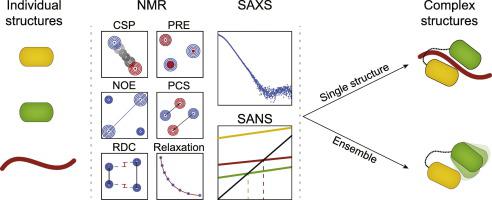当前位置:
X-MOL 学术
›
J. Mol. Biol.
›
论文详情
Our official English website, www.x-mol.net, welcomes your
feedback! (Note: you will need to create a separate account there.)
Current approaches for integrating solution NMR spectroscopy and small-angle scattering to study the structure and dynamics of biomolecular complexes.
Journal of Molecular Biology ( IF 4.7 ) Pub Date : 2020-03-19 , DOI: 10.1016/j.jmb.2020.03.014 Florent Delhommel 1 , Frank Gabel 2 , Michael Sattler 1
Journal of Molecular Biology ( IF 4.7 ) Pub Date : 2020-03-19 , DOI: 10.1016/j.jmb.2020.03.014 Florent Delhommel 1 , Frank Gabel 2 , Michael Sattler 1
Affiliation

|
The study of complex and dynamic biomolecular assemblies is a key challenge in structural biology and requires the use of multiple methodologies providing complementary spatial and temporal information. NMR spectroscopy is a powerful technique that allows high-resolution structure determination of biomolecules as well as investigating their dynamic properties in solution. However, for high-molecular-weight systems, such as biomolecular complexes or multi-domain proteins, it is often only possible to obtain sparse NMR data, posing significant challenges to structure determination. Combining NMR data with information obtained from other solution techniques is therefore an attractive approach. The combination of NMR with small-angle X-ray and/or neutron scattering has been shown to be particularly fruitful. These scattering approaches provide low-resolution information of biomolecules in solution and reflect ensemble-averaged contributions of dynamic conformations for scattering molecules up to megadalton molecular weight. Here, we review recent developments in the combination of nuclear magnetic resonance spectroscopy (NMR) and small-angle scattering (SAS) experiments. We briefly outline the different types of information that are provided by these techniques. We then discuss computational methods that have been developed to integrate NMR and SAS data, particularly considering the presence of dynamic structural ensembles and flexibility of the investigated biomolecules. Finally, recent examples of the successful combination of NMR and SAS are presented to illustrate the utility of their combination.
中文翻译:

目前整合溶液NMR光谱和小角度散射的方法,以研究生物分子复合物的结构和动力学。
复杂而动态的生物分子组装体的研究是结构生物学中的关键挑战,需要使用多种方法来提供互补的时空信息。NMR光谱技术是一项强大的技术,可以对生物分子进行高分辨率的结构测定以及研究其在溶液中的动态特性。但是,对于高分子量系统,例如生物分子复合物或多域蛋白,通常只能获得稀疏的NMR数据,这对结构确定提出了重大挑战。因此,将NMR数据与从其他解决方案技术获得的信息相结合是一种有吸引力的方法。NMR与小角X射线和/或中子散射的结合已被证明是特别有效的。这些散射方法提供了溶液中生物分子的低分辨率信息,并反映了动态构象的整体平均贡献,这些动力学构象用于散射分子量高达兆达尔顿的分子。在这里,我们回顾了核磁共振波谱(NMR)和小角度散射(SAS)实验相结合的最新进展。我们简要概述了这些技术提供的不同类型的信息。然后,我们将讨论已开发出的用于整合NMR和SAS数据的计算方法,特别是考虑到动态结构集合的存在和所研究生物分子的灵活性。最后,提供了NMR和SAS成功组合的最新示例,以说明它们组合的实用性。
更新日期:2020-03-19
中文翻译:

目前整合溶液NMR光谱和小角度散射的方法,以研究生物分子复合物的结构和动力学。
复杂而动态的生物分子组装体的研究是结构生物学中的关键挑战,需要使用多种方法来提供互补的时空信息。NMR光谱技术是一项强大的技术,可以对生物分子进行高分辨率的结构测定以及研究其在溶液中的动态特性。但是,对于高分子量系统,例如生物分子复合物或多域蛋白,通常只能获得稀疏的NMR数据,这对结构确定提出了重大挑战。因此,将NMR数据与从其他解决方案技术获得的信息相结合是一种有吸引力的方法。NMR与小角X射线和/或中子散射的结合已被证明是特别有效的。这些散射方法提供了溶液中生物分子的低分辨率信息,并反映了动态构象的整体平均贡献,这些动力学构象用于散射分子量高达兆达尔顿的分子。在这里,我们回顾了核磁共振波谱(NMR)和小角度散射(SAS)实验相结合的最新进展。我们简要概述了这些技术提供的不同类型的信息。然后,我们将讨论已开发出的用于整合NMR和SAS数据的计算方法,特别是考虑到动态结构集合的存在和所研究生物分子的灵活性。最后,提供了NMR和SAS成功组合的最新示例,以说明它们组合的实用性。











































 京公网安备 11010802027423号
京公网安备 11010802027423号